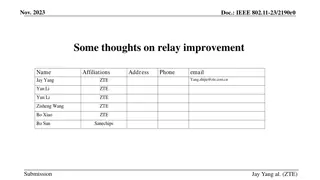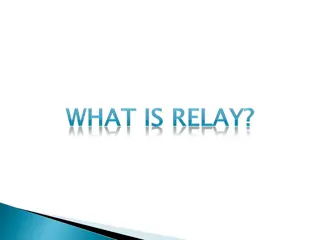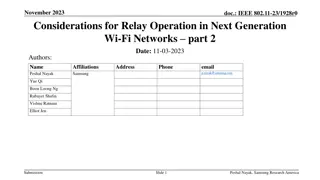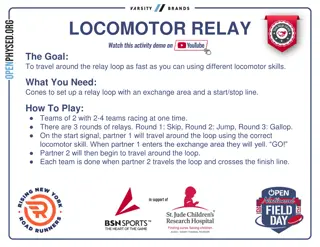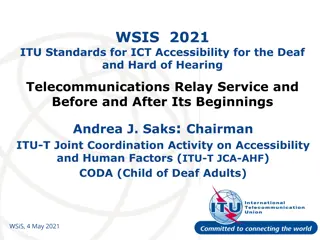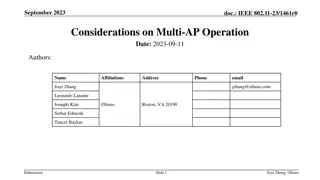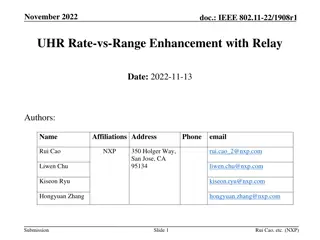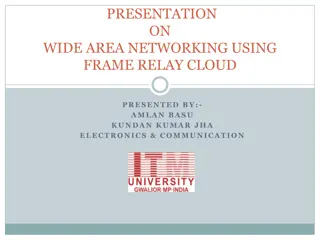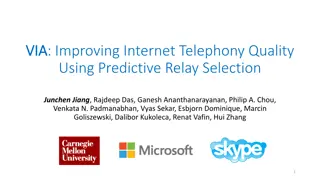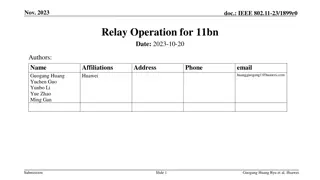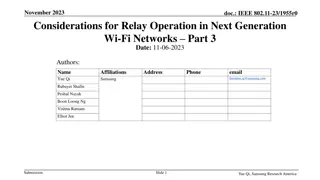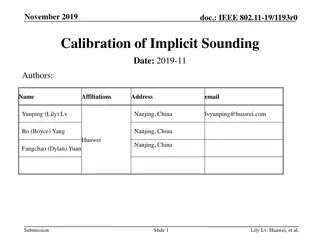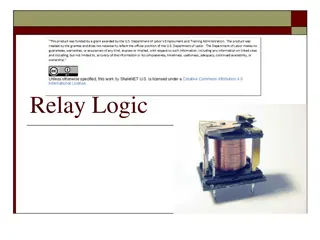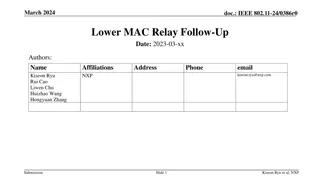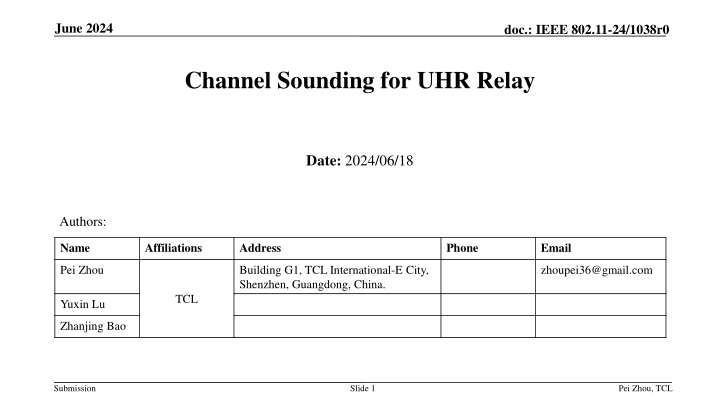
Advanced Channel Sounding Methods for IEEE 802.11 Relay Networks
Explore the innovative channel sounding techniques for relay networks in IEEE 802.11, focusing on multiple relay scenarios. Enhance QoS and throughput in relay operations by selecting optimal relay STAs based on intensive channel measurements. Introduce AP and non-AP initiated sounding procedures to address existing limitations and improve overall network performance.
Download Presentation

Please find below an Image/Link to download the presentation.
The content on the website is provided AS IS for your information and personal use only. It may not be sold, licensed, or shared on other websites without obtaining consent from the author. If you encounter any issues during the download, it is possible that the publisher has removed the file from their server.
You are allowed to download the files provided on this website for personal or commercial use, subject to the condition that they are used lawfully. All files are the property of their respective owners.
The content on the website is provided AS IS for your information and personal use only. It may not be sold, licensed, or shared on other websites without obtaining consent from the author.
E N D
Presentation Transcript
June 2024 doc.: IEEE 802.11-24/1038r0 Channel Sounding for UHR Relay Date: 2024/06/18 Authors: Name Affiliations Address Phone Email Pei Zhou Building G1, TCL International-E City, Shenzhen, Guangdong, China. zhoupei36@gmail.com TCL Yuxin Lu Zhanjing Bao Submission Slide 1 Pei Zhou, TCL
June 2024 doc.: IEEE 802.11-24/1038r0 Introduction As stated in the UHR PAR [1], Rate-vs-Range throughput improvement is the first essential scope of IEEE 802.11bn. There are a lot of contributions [2] - [9] discussed how to use relay in IEEE 802.11bn. Most of them are focus on relay operation/transmission. Contributions [2] and [3] proposed the DL sounding and UL sounding for the relay link, mainly focus on single relay case. Contribution [4] proposed the concept of opportunistic relaying. There may be multiple relay candidate STAs in a BSS. Non-AP STAs that can act as a relay b/w the AP and End STA E.g. other mobile devices owned by user and family, laptops, appliances in the house In this contribution, we discuss some possible channel sounding sequences for relay link, including multiple relays case. Submission Slide 2 Pei Zhou, TCL
June 2024 doc.: IEEE 802.11-24/1038r0 Recap [2] and [3]: Channel information between Relay STA and non-AP STA(s) To provide the improved QoS (i.e., reliability and throughput) in relay operation, the channel information between Relay STA and non-AP STA(s) should be measured. [2] [3] DL sounding for the relay link UL sounding for the relay link Submission Slide 3 Pei Zhou, TCL
June 2024 doc.: IEEE 802.11-24/1038r0 Discussions The scenario in [2] and [3] is that, there is only one Relay STA. Some STAs (e.g., BSS edge) need to use this Relay STA to communicate with AP. However, there may be more than one Relay (capable) STA in a BSS [4]. (BSS edge) STAs may be served by different Relay STAs depends on the distance (location) or channel condition. Thus, the channel information (e.g., CSI, RSSI) between STA and different Relay STAs (also, between AP and Relay STA) needs to be measured. Then, the optimal (or a suitable) Relay STA can be selected for each STA. A straightforward way to extend the sounding method proposed in [2] and [3] to multiple relay STAs scenario is that: AP does the proposed sounding sequence multiple times, as shown below. Report Request Report Request Trigger Trigger AP Sounding PPDU Relay 1 (STA 1) Sounding PPDU Relay 2 (STA 2) Feedback Feedback STA 3 Note: Taking the DL sounding as an example (UL sounding is similar). Submission Slide 4 Pei Zhou, TCL
June 2024 doc.: IEEE 802.11-24/1038r0 Motivations The sounding methods in previous slides have the following drawbacks: 1) The sounding sequence/signaling of multiple relay STAs scenario is time consuming. 2) Lack of the sounding procedure initiated by non-AP STA. Note: There is the case that non-AP STA finds/determines the quality of direct link (i.e., between itself and associated AP) is poor. Then, non-AP STA may initiate channel sounding of the relay link(s) and use the optimal relay STA to improve the Rate-vs-Range throughput. Therefore, we propose the following additional sounding methods for relay operation. AP initiated parallel sounding (in multiple Relay STAs scenario) Non-AP STA initiated sounding Submission Slide 5 Pei Zhou, TCL
June 2024 doc.: IEEE 802.11-24/1038r0 AP initiated parallel sounding AP initiated parallel sounding in multiple Relay STAs scenario (Similar to .11bf TF sounding phase - SR2SR variant) Report Request Trigger Option 1: AP collects Measurement Report directly Step 1: AP sends Trigger frame to Relay STAs and the target STA 3 to initiate the sounding of relay links. Step 2: The intended Relay STAs send sounding PPDUs simultaneously. STA 3 measures the Sounding PPDUs to obtain the CSI of second hop (between STA 3 and Relay STAs). Step 3: AP may send Report Request to STA 3 to get the measurement report of the second hop. Step 4: STA 3 reports the measurement report to AP (either solicited by Step 3 or unsolicited). AP Sounding PPDU Relay 1 (STA 1) Sounding PPDU Relay 2 (STA 2) Measurement Report STA 3 STA 3 measures Sounding PPDU Note: If Step 3 and Step 4 are executed, AP could select a suitable (or the optimal) Relay STA for the intended STA 3 based on the quality of second hop. Submission Slide 6 Pei Zhou, TCL
June 2024 doc.: IEEE 802.11-24/1038r0 AP initiated parallel sounding AP initiated parallel sounding in multiple Relay STAs scenario Option 2: AP collects Measurement Report via Relay STA Step 1: Same as Option 1 Step 2: Same as Option 1 But, AP could measure RSSI of Sounding PPDUs. Then, AP selects a suitable (optimal) Relay STA (e.g., Relay 1 with highest RSSI value) to collect Measurement Report. Step 3: AP sends Report Request to Relay 1 to request the Measurement Report of the second hop. Step 4: Relay 1 sends the Report Request to STA 3. Step 5: STA 3 reports the measurement report to Relay 1. Step 6: Relay 1 relays the Measurement Report (of the second hop) to AP. Report Request AP measures RSSIs (Relay 1 is better) Trigger AP Sounding PPDU (Relayed) (Relayed) Report Request Measurement Report Relay 1 (STA 1) Sounding PPDU Relay 2 (STA 2) Measurement Report STA 3 STA 3 measures Sounding PPDU Note: If Step 3 to Step 6 are executed, AP could select a suitable (or the optimal) Relay STA for the intended STA 3 based on the quality of second hop. Submission Slide 7 Pei Zhou, TCL
June 2024 doc.: IEEE 802.11-24/1038r0 STA initiated sounding method 1 STA sends NDPA + NDP, STA requests Measurement Report (same as EHT TB sounding) Step 1: STA 3 sends NDPA frame to Relay STAs to initiate the sounding of the second hop relay link. Step 2: STA 3 sends NDP SIFS after the NDPA The intended Relay STAs measure NDP to obtain the CSI of second hop (between STA 3 and Relay STAs). Step 3: STA 3 sends Report Request (e.g., BFRP Trigger) to intended Relay STAs to request Measurement Report. Step 4: Relay STAs report the Measurement Report to STA 3. AP Relay 1 measures NDP Measurement Report Relay 1 (STA 1) Relay 2 measures NDP Measurement Report Relay 2 (STA 2) Report Request NDP NDPA STA 3 In this case, STA 3 selects the optimal Relay STA for itself based on the Measurement Report of the second hop. Note: Sequential sounding for each Relay STA is also possible. Submission Slide 8 Pei Zhou, TCL
June 2024 doc.: IEEE 802.11-24/1038r0 STA initiated sounding method 2 STA sends NDPA + NDP, Relay STAs send NDP (similar to .11bf Non-TB sensing measurement exchange) Step 1: STA 3 sends NDPA frame to Relay STAs to initiate the sounding of the second hop relay link. Step 2: STA 3 sends NDP SIFS after the NDPA The intended Relay STAs measure NDP to obtain the CSI of second hop (between STA 3 and Relay STAs). Step 3: Relay STAs send NDPs SIFS after the NDP sent by STA 3 STA 3 can measure the NDPs to obtain the CSI of second hop (between STA 3 and Relay STAs). Step 4: Relay STAs send Measurement Reports to STA 3. Note: Step 4 is optional, if channel reciprocity is possible. In this case, STA 3 selects the optimal Relay STA for itself based on the Measurement Report of the second hop. AP Measurement Report NDP Relay 1 (STA 1) Measurement Report NDP Relay 2 (STA 2) NDP NDPA STA 3 STA 3 measures NDPs Note: Sequential sounding for each Relay STA is also possible. Submission Slide 9 Pei Zhou, TCL
June 2024 doc.: IEEE 802.11-24/1038r0 Summary We proposed several channel sounding methods for relay operation, mainly focus on multiple relays scenario. AP initiated channel sounding for relay link STA initiated channel sounding for relay link Next Step Detailed frame formats design Submission Slide 10 Pei Zhou, TCL
June 2024 doc.: IEEE 802.11-24/1038r0 Straw Poll 1 Do you agree to support the following channel sounding procedure as the channel sounding method for relay operation in TGbn? AP can initiate the channel sounding between relay node and non-AP STA. Note: The detailed channel sounding sequence and related frame formats are TBD. Y/N/A Submission Slide 11 Pei Zhou, TCL
June 2024 doc.: IEEE 802.11-24/1038r0 Straw Poll 2 Do you agree to support the following channel sounding procedure as the channel sounding method for relay operation in TGbn? Non-AP can initiate the channel sounding between itself and relay node. Note: The detailed channel sounding sequence and related frame formats are TBD. Y/N/A Submission Slide 12 Pei Zhou, TCL
June 2024 doc.: IEEE 802.11-24/1038r0 References [1] 11-23-0480-03-0uhr-uhr-proposed-par [2] 11-23-1138-01-0uhr-features-to-consider-for-efficient-relay-operation [3] 11-23-1840-02-00bn-relay-for-11bn [4] 11-24-0650-01-00bn-a-case-for-opportunistic-relaying [5] 11-23-1146-01-0uhr-relaying-for-low-latency-traffic-in-uhr [6] 11-23-1175-00-0uhr-uhr-relay-follow-up [7] 11-23-1969-00-00bn-consideration-on-uhr-relay-architecture [8] 11-23-1948-00-00bn-txop-sharing-based-ul-relaying [9] 11-24-0385-01-00bn-discussion-on-11bn-relay-operation Submission Slide 13 Pei Zhou, TCL



